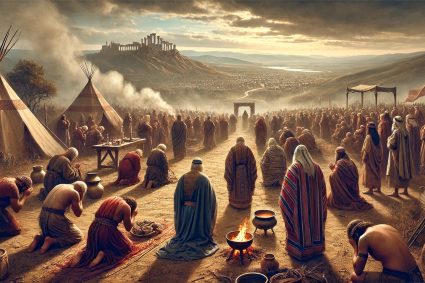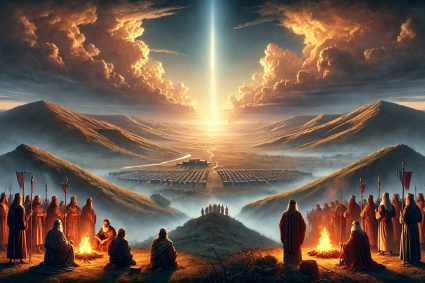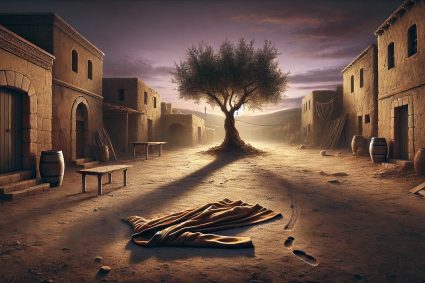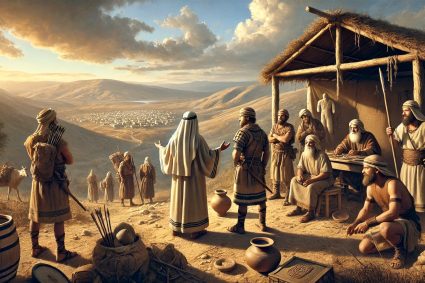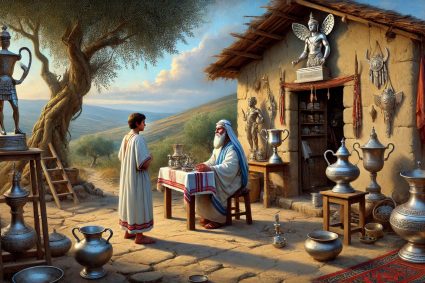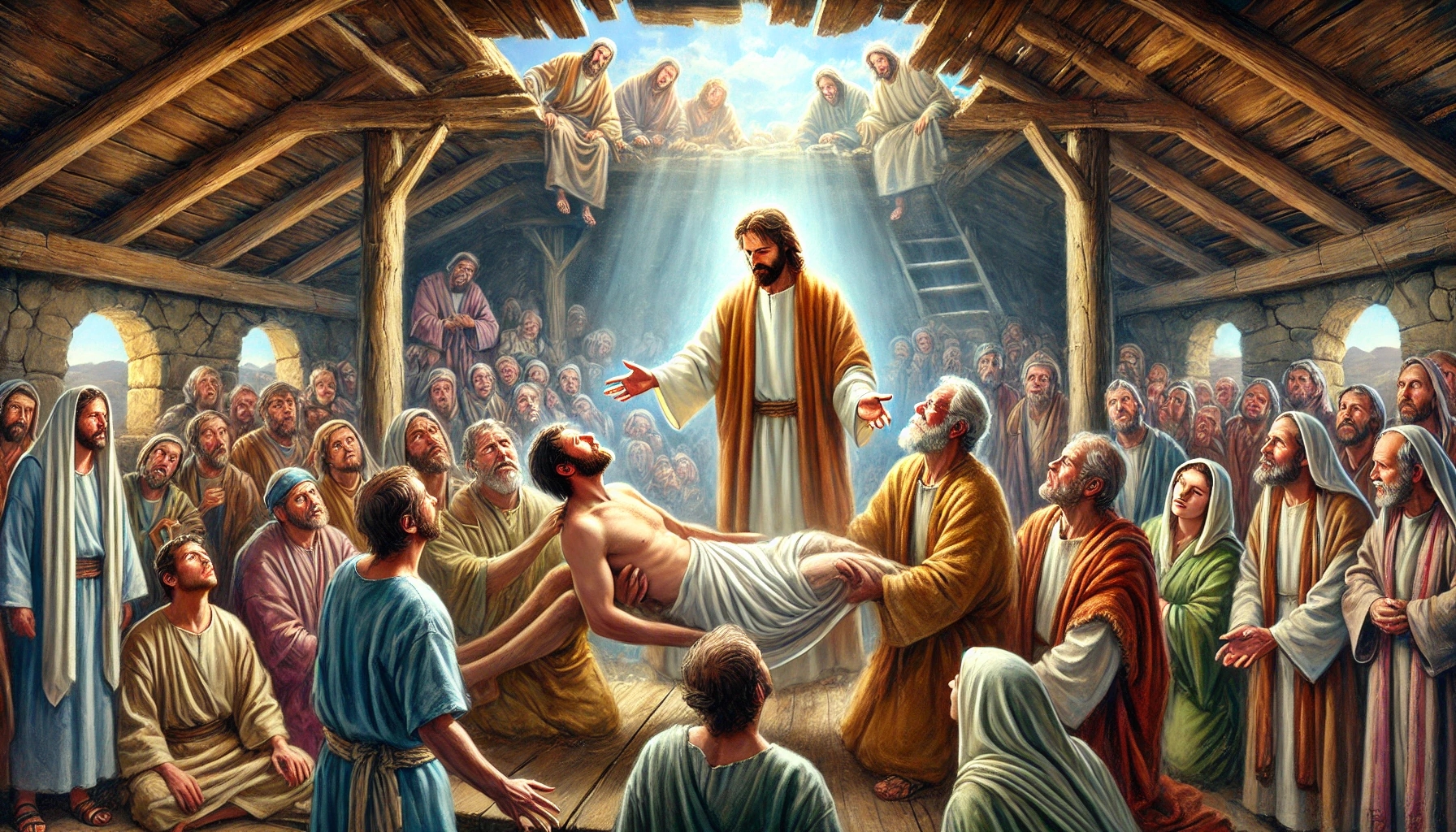
August 29, 2024
DAILY BIBLE READING – Mark Chapter 2
1 And again he entered into Capernaum after some days; and it was noised that he was in the house.
2 And straightway many were gathered together, insomuch that there was no room to receive them, no, not so much as about the door: and he preached the word unto them.
3 And they come unto him, bringing one sick of the palsy, which was borne of four.
4 And when they could not come nigh unto him for the press, they uncovered the roof where he was: and when they had broken it up, they let down the bed wherein the sick of the palsy lay.
5 When Jesus saw their faith, he said unto the sick of the palsy, Son, thy sins be forgiven thee.
6 But there was certain of the scribes sitting there, and reasoning in their hearts,
7 Why doth this man thus speak blasphemies? who can forgive sins but God only?
8 And immediately when Jesus perceived in his spirit that they so reasoned within themselves, he said unto them, Why reason ye these things in your hearts?
9 Whether is it easier to say to the sick of the palsy, Thy sins be forgiven thee; or to say, Arise, and take up thy bed, and walk?
10 But that ye may know that the Son of man hath power on earth to forgive sins, (he saith to the sick of the palsy,)
11 I say unto thee, Arise, and take up thy bed, and go thy way into thine house.
12 And immediately he arose, took up the bed, and went forth before them all; insomuch that they were all amazed, and glorified God, saying, We never saw it on this fashion.
13 And he went forth again by the sea side; and all the multitude resorted unto him, and he taught them.
14 And as he passed by, he saw Levi the son of Alphaeus sitting at the receipt of custom, and said unto him, Follow me. And he arose and followed him.
15 And it came to pass, that, as Jesus sat at meat in his house, many publicans and sinners sat also together with Jesus and his disciples: for there were many, and they followed him.
16 And when the scribes and Pharisees saw him eat with publicans and sinners, they said unto his disciples, How is it that he eateth and drinketh with publicans and sinners?
17 When Jesus heard it, he saith unto them, They that are whole have no need of the physician, but they that are sick: I came not to call the righteous, but sinners to repentance.
18 And the disciples of John and of the Pharisees used to fast: and they come and say unto him, Why do the disciples of John and of the Pharisees fast, but thy disciples fast not?
19 And Jesus said unto them, Can the children of the bridechamber fast, while the bridegroom is with them? as long as they have the bridegroom with them, they cannot fast.
20 But the days will come, when the bridegroom shall be taken away from them, and then shall they fast in those days.
21 No man also seweth a piece of new cloth on an old garment: else the new piece that filled it up taketh away from the old, and the rent is made worse.
22 And no man putteth new wine into old bottles: else the new wine doth burst the bottles, and the wine is spilled, and the bottles will be marred: but new wine must be put into new bottles.
23 And it came to pass, that he went through the corn fields on the sabbath day; and his disciples began, as they went, to pluck the ears of corn.
24 And the Pharisees said unto him, Behold, why do they on the sabbath day that which is not lawful?
25 And he said unto them, Have ye never read what David did, when he had need, and was an hungred, he, and they that were with him?
26 How he went into the house of God in the days of Abiathar the high priest, and did eat the shewbread, which is not lawful to eat but for the priests, and gave also to them which were with him?
27 And he said unto them, The sabbath was made for man, and not man for the sabbath:
28 Therefore the Son of man is Lord also of the sabbath.
King James Version. Public Domain
Commentary
Introduction
The second chapter of the Gospel of Mark presents a striking portrayal of the growing tensions between Jesus and the religious authorities of His time. It begins with the well-known story of the healing of a paralytic, which not only demonstrates Jesus’ miraculous power but also His authority to forgive sins. The chapter continues with the calling of the tax collector Levi and a feast with tax collectors and sinners, leading to further confrontations with the Pharisees. Finally, the chapter addresses two more controversial issues: fasting and the observance of the Sabbath. These sections highlight Jesus’ radical message, challenging traditional religious practices and introducing a new perspective on the law and faith.
Commentary
The healing of the paralytic is a central moment in the Gospel, emphasizing Jesus’ power not only as a miracle worker but also as one who possesses the authority to forgive sins. This act provokes the scribes, who accuse Jesus of blasphemy, since, according to Jewish understanding, only God can forgive sins. Jesus uses this opportunity to underline the connection between physical healing and spiritual forgiveness, thereby affirming His divine authority.
The calling of Levi and the subsequent meal with tax collectors and sinners exemplify Jesus’ missionary approach. He deliberately turns to the marginalized and despised, provoking further criticism from religious leaders. Jesus’ response that “it is not the healthy who need a doctor, but the sick” reveals His priorities: He has come to call sinners, not the righteous. This underscores His role as a savior reaching out to those in greatest need.
In the matter of fasting and the Sabbath, Jesus reveals a profound insight into the nature of religious rituals. He questions the rigid adherence to laws and demonstrates that love and human well-being take precedence over religious prescriptions. Particularly significant is His statement that “the Sabbath was made for man, not man for the Sabbath,” which emphasizes flexibility and humanity in the interpretation of the law.
Summary
Mark Chapter 2 depicts Jesus as a powerful and provocative figure who challenges existing religious norms. Through the healing of the paralytic, He demonstrates His divine authority to forgive sins. His interactions with Levi and other sinners reveal His willingness to include the marginalized in the community. Finally, the discussions on fasting and the Sabbath offer insights into Jesus’ understanding of the law, which always aims at the well-being of people. This chapter illustrates how Jesus questions traditional religious notions and introduces a new perspective based on grace and compassion.
![]()

WEEKLY SPIRIT OF PROPHECY READING – Ellen White | The Desire of Ages Chapter 58—“Lazarus, Come Forth”
This chapter is based on Luke 10:38-42; John 11:1-44.
Read online here
Commentary
The chapter “Lazarus, Come Fourth” describes one of the most powerful and symbolic episodes in the ministry of Jesus. The raising of Lazarus from the dead is not only a remarkable miracle but also a profound testament to Jesus’ divine authority and love for his friends. This chapter uniquely brings together faith, hope, and the nature of divine providence.
Lazarus and the Family in Bethany:
Lazarus, along with his sisters Mary and Martha, are among Jesus’ most devoted followers. The close bond between them and Jesus goes far beyond what one would expect in a mere teacher-student relationship. The house in Bethany, home to Lazarus and his sisters, often serves as a refuge for Jesus, a place of peace and friendship where he can rest from the demands of his public ministry. This deep emotional connection becomes particularly evident when Lazarus falls ill and eventually dies.
Jesus’ Reaction to Lazarus’ Death:
Interestingly, Jesus hesitates to go to Bethany upon hearing of Lazarus’ illness. This delay initially seems puzzling, especially to the disciples who are aware of Jesus’ deep affection for Lazarus and his family. However, Jesus’ delay is intentional and serves a greater purpose: the glorification of God and the strengthening of his disciples’ faith. Jesus knows that the forthcoming miracle, the resurrection of Lazarus, will provide a powerful demonstration of his divine power and his identity as the Messiah.
The Dialogue with Martha and Mary:
When Jesus finally arrives in Bethany, he is greeted by Martha, who affirms her faith in him but is still sorrowful over her brother’s death. Jesus uses this moment to strengthen both Martha’s and Mary’s faith by telling them that he himself is “the resurrection and the life.” These words are central, as they not only point to the imminent resurrection of Lazarus but also to the deeper truth that Jesus embodies eternal life itself.
The Raising of Lazarus:
The climax of the chapter is undoubtedly the scene where Jesus calls Lazarus out of the tomb. This act is so powerful and majestic that it dispels any doubts about Jesus’ divine nature. The miracle is a symbolic act that foreshadows the future resurrection of all believers and demonstrates Jesus’ sovereignty over life and death. The reaction of those present—a mixture of astonishment, joy, and gratitude—highlights the profound emotional and spiritual impact of this miracle.
Significance for Faith:
The raising of Lazarus is not only a physical miracle but also a spiritual sign. It shows that faith in Jesus offers a living hope for eternal life, a hope that extends beyond death. Jesus demonstrates that death does not have the final word, but that through him, life triumphs. For the disciples and all who witness this event, it becomes clear that Jesus is indeed the Son of God, who has come to establish the Kingdom of God on earth.
The Deep Humanity of Jesus:
What is particularly moving is the portrayal of Jesus’ deep compassion. Although he knows that he will raise Lazarus from the dead, he weeps with those who mourn. These tears reveal Jesus’ full humanity and his capacity to experience genuine pain and loss. It presents a picture of Jesus that brings him closer to us: the divine Savior who is fully human, suffering with us and understanding our suffering.
Conclusion:
The chapter “Lazarus, Come Fourth” illustrates that Jesus’ actions and words are always directed toward a deeper, divine purpose—revealing his nature and mission to bring life that transcends death. The resurrection of Lazarus is a precursor to the final resurrection and a powerful symbol of the victory of life over death. It reminds us that in times of suffering and darkness, faith in Christ can lead us to a new life that surpasses our current reality.
Visited 33 times, 1 visit(s) today

